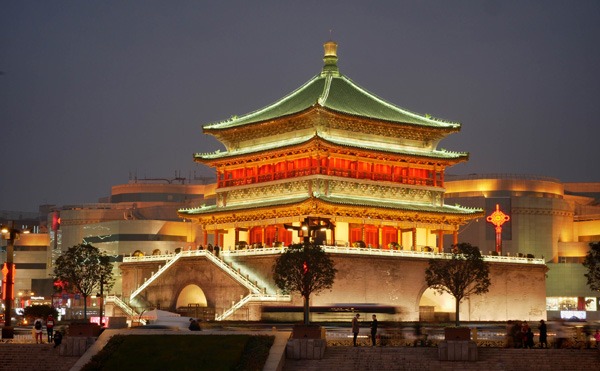
by successfulbob | Guest Post, photography, travel photography
Travel in China – Xi’an – Part Three
Guest Post – Ken MacAdams
See the previous posts from Ken on Xi’an, China. Part One and Part Two
“Discovered in 1974 by a peasant digging a well, the tomb area covers about 22 square miles. The main part of the emperor’s tomb has yet to be excavated, but three pits have been discovered and excavation work continues to this day. Some estimate that there are over 8,000 clay warriors at the site. These pottery figures of soldiers, horses and chariots leave no doubt that the emperor wanted a bodyguard in the afterlife. Pit 1 alone has yielded over 6,000 soldiers, plus horsemen and chariots. These soldiers are slightly larger than life size, and each is different from the others. The soldiers wear a variety of uniforms and body armor, different hair styles, and some sport mustaches. Some are kneeling – indicating they were archers holding now-decayed wooden bows or cross-bows, while others would have held swords or pikes. The figures are a fascinating link to a society 22 centuries ago.
 This is the Bell Tower with contrasting modern buildings in the background.
This is the Bell Tower with contrasting modern buildings in the background.
During the daytime you can enter both the Bell and Drum Towers. A few dynasties – and centuries – later, the Ming dynasty erected one of the most famous and best examples of ancient city walls. Construction of the still standing present day wall began on the remains of the old Sui and Tang dynasty walls. Encompassing the old city, the square shaped Ming Wall is 8.5 miles in circumference, 40 ft. tall, and about 45 ft. wide on top. It was purposely built wide enough that two chariots could pass by each other with ease. A moat surrounds the wall, and there were four gates into the city, one on the North, East, South, and West sides. The South Gate is the best preserved example with it’s massive archers tower still intact, along with the drawbridge. Xi’an’s Old City Wall is the only ancient wall in China to have survived the Cultural Revolution in its entirety.
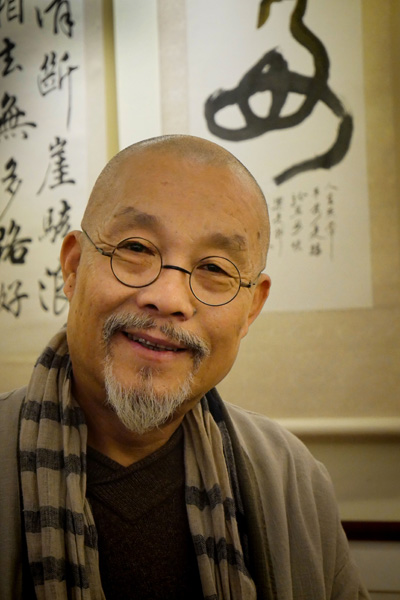 This is an artist in the Art Gallery District who invited us in to join him for a tea ceremony. After visiting, he painted a calligraphy spread, and insisted we take it as a gift! Some of his work is hanging in the background.
This is an artist in the Art Gallery District who invited us in to join him for a tea ceremony. After visiting, he painted a calligraphy spread, and insisted we take it as a gift! Some of his work is hanging in the background.Each Ming city had a bell and drum tower. The bell was sounded at dawn, and drum at dusk. The original bell no longer exists, but a replica stands on the corner of the tower. The bell and drum signaled the opening and closing the city gates. Several cities still have their bell and drum towers, but Xi’an’s is the most widely known of all of them. The Bell Tower was built in 1384 AD and the Drum Tower built four years earlier, in 1380. Today, both towers, and all wall buildings are outlined in colorful LED lights that come on at dusk. The lighting is tastefully done, and adds a special magic to the night air of Old Town Xi’an!
A few blocks away is Xi’an’s Muslim community. Within is the Great Mosque, surrounded by old houses and narrow streets. The Great Mosque survived the Cultural Revolution and remains as an Islamic place of worship. It was founded in AD 742, and the present layout dates from the 14th century.
About 146 BC, during the Han dynasty, Emperor Han Wudi launched a series of military campaigns against the warlike Turkish people to the Northwest. Merchant caravans followed the armies, and established routes that the Europeans later called the Silk Road. Originating in Xi’an, these routes formed links of trade and cultural exchange to the West. Paper, gunpowder, (both Chinese inventions), spices, silk, jade, and many other goods were carried by merchant caravans to the West.
The first contacts between adherents of Buddhism and the Chinese were made by the opening of the Silk Road. (It was via this same link that the Muslim faith came into China.) During the Tang dynasty, Xi’an became the main center for Buddhist learning in Asia. A number of monuments bear witness to the importance of Buddhism in the city’s history. Two prominent landmarks still standing today are the Big and Little Goose Pagodas. Numerous Chinese monks, scholars and translators are recorded having made the journey to India in search of enlightenment. It was at the Little Goose Pagoda where monks spent 20 years translating and converting the Indian language documents into Chinese. The Big Goose Pagoda may have been at tall as 12 stories, but either fire or an earthquake (historical documents vary) damaged the original structure, and it was reduced to 7 stories, as it stands today. You can climb 288 steps inside to the top of the pagoda. On a clear day, your efforts will reward you great views of the surrounding city.
Today, Xi’an continues to grow. By 1954 the city outgrew the Old City walls, and began to spread. The population today stands at about 11 million, of which I’m told 1 million are university students. Pharmaceuticals, electronics, and auto parts are among the industries here, and agriculture plays a significant role in the surrounding area.
In a culture significantly different from ours, I’ve made multiple friends and acquaintances that welcome me back year after year. Each visit I find new subjects to train my lens on, or in some cases, explore a new angle to shoot from. This land is intriguing, charming, and wonderful to experience up close and personal. It’s also a land that’s changing – and changing fast! I’m glad to be documenting some of the ancient along with that change.”
Ken has always loved to travel, so when he made a common connection with the fact that either a long day pounding the streets of some foreign city, or shooting the last dance at a wedding, a good part of his physical

weariness came from lugging around his big heavy DSLR. That’s when he started looking at alternatives – and ended up selecting Panasonic Lumix Micro Four Thirds gear.
Ken is rarely without a camera, and the next great photo travel experience – whether local or abroad – is always in the back of his mind! A longtime resident of the Four Corners, and when he’s not out on the road, he enjoys some of the great outdoor opportunities found there – mountain biking, hiking, and Jeeping.
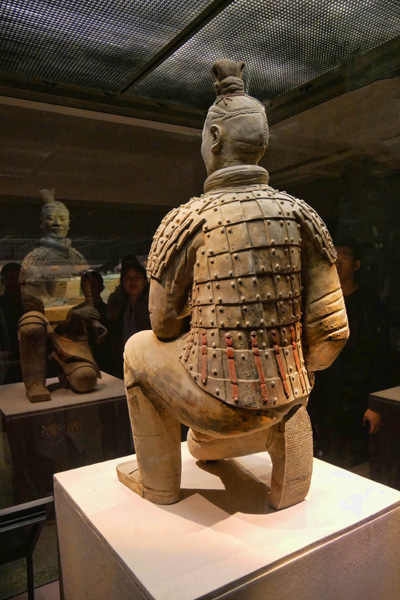
by successfulbob | Guest Post, landscape photography, Lumix G9, photography, travel photography
Travel in China – Xi’an – Part Two
Guest Post – Ken MacAdams
Ken’s continuing images and stories from Xi’an, China. See the last post here.
“For this blog edition, let me introduce you to some background of this interesting locale.
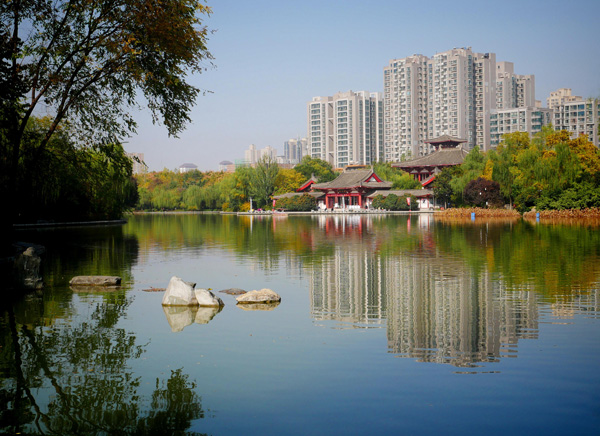 This is Fengqing Park, one of the many beautiful parks within the city.
This is Fengqing Park, one of the many beautiful parks within the city.
It’s a quiet place where the locals come from dawn to dusk.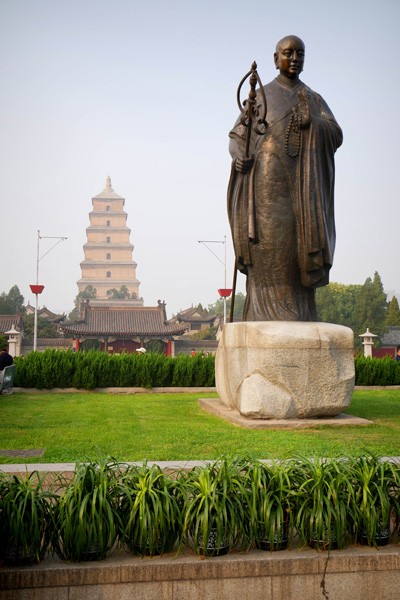 Wild Goose Pagoda with the statue of the monk credited with bringing Buddhism to China.
Wild Goose Pagoda with the statue of the monk credited with bringing Buddhism to China.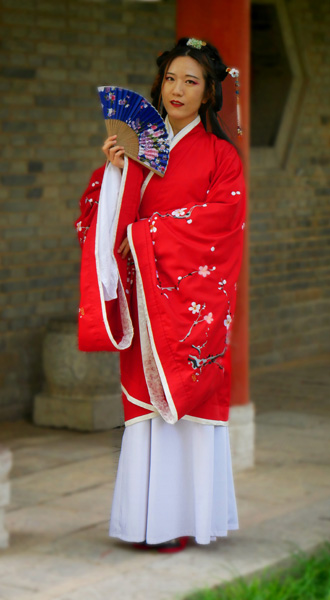 Woman dressed in Period costume at the Little Goose Pagoda.
Woman dressed in Period costume at the Little Goose Pagoda.In the history of China, Xi’an has played a large and significant role – one that stretches longer in time than perhaps any other city in China. It acted as the capital of China for over 1,100 years, and has never fallen out of importance. Archaeological and art discoveries in and around the city tell a tale of China’s development from prehistoric times until the height of the imperial period. Many tombs and sites remain un excavated to this day. Xi’an is geographically located in the center of present day China.
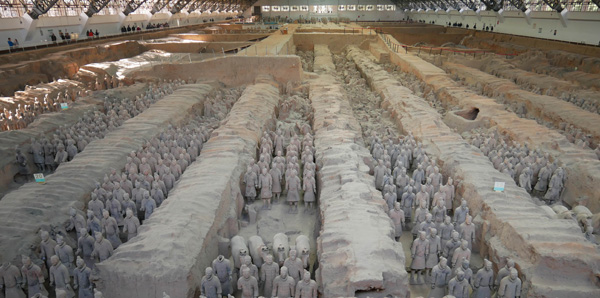 Pit 1. This is the first pit that was discovered and where excavation began.
Pit 1. This is the first pit that was discovered and where excavation began.
It is estimated there are 6,000 soldiers buried here. Note the armor detail and remaining paint pigment. The sole of his shoe even has tread detail!
Note the armor detail and remaining paint pigment. The sole of his shoe even has tread detail!Xi’an lies on the Wei River in the Shaanxi Province, and served as capital at different times for the Zhou, Han, Sui, and Tang dynasties. The origins of Xi’an can be traced to the 11th century BC, when rulers of the Zhou dynasty founded a city about 10 miles from present day Xi’an. In 221 BC the King of Qin conquered the other feudal kingdoms in the region to become the First Emperor. During his rule, he extended various sections of the Great Wall to keep out the fierce northern tribesmen, but perhaps more notable was his standardization of the Chinese written language, coinage, and weights and measures. It was Qin who was responsible for another of the greatest wonders of the ancient world – his army of terracotta warriors.
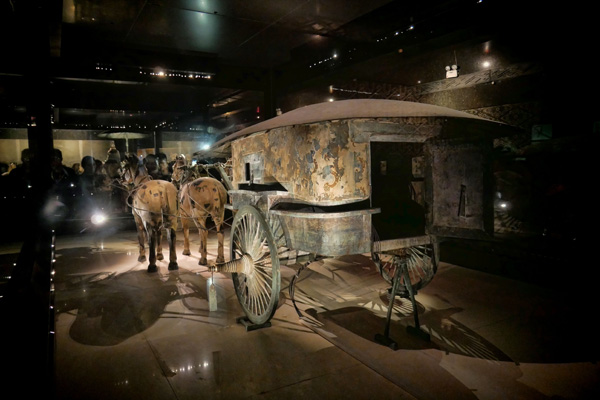 This is the bronze chariot for the Emperor. It weighs almost 2,000 lbs., and silk fabric was found inside.
This is the bronze chariot for the Emperor. It weighs almost 2,000 lbs., and silk fabric was found inside. More from Ken’s adventures next week!
Ken has always loved to travel, so when he made a common connection with the fact that either a long day pounding the streets of some foreign city, or shooting the last dance at a wedding, a good part of his physical

weariness came from lugging around his big heavy DSLR. That’s when he started looking at alternatives – and ended up selecting Panasonic Lumix Micro Four Thirds gear.
Ken is rarely without a camera, and the next great photo travel experience – whether local or abroad – is always in the back of his mind! A longtime resident of the Four Corners, and when he’s not out on the road, he enjoys some of the great outdoor opportunities found there – mountain biking, hiking, and Jeeping.

by successfulbob | Guest Post, Marketing Monday, photography, photography education, photography marketing
Portrait Pricing Guidelines with Steve Bedell – Part Four
Marketing Monday Guest Post
Here is Steve’s continuation from part 1 and part 2 and part 3 portrait pricing
“Six: Wall portrait bonus
We all know the money is in the wall portraits and wall groupings. So from our initial contact right through the sales session that’s what we should be striving for. To drive that point home, I offer a discounted price of about 30% off on gift prints when they purchase a portrait 20 inches or larger. (Note: The discounted price is the price I feel I should sell that product for. If they don’t have a wall portrait I am just more profitable on the smaller prints)

SEVEN: Albums
I know many photographers like albums. I am not a huge fan. You either have to take the time to do the layout or pay someone to do it (my choice). I know you can get big numbers from them but make sure you cover all your bases, including time, when deciding the pricing.
I prefer Album boxes. Make a few 5×7’s for peanuts, slide into 8×10 mats and put into the box. Pretty simple plus if you make an error in any image you just change out one print.
EIGHT: ALWAYS list most expensive product first
I’m firm on this one; this is pretty much an unbreakable rule. People read from the top down, left to right. Start out with that 40×60 for half a million bucks (you wish) and by the time they get down to that 16×20 for $800 it’s going to look pretty inexpensive. The mind works this way, at first they think ‘Oh my God, I can’t afford this’ to ‘Well, that’s more in my budget’. Start small to large and it’s an uphill battle.
It works the same way with your good/better/best pricing, always list the most expensive product first or right to left.
NINE: Session fees
OK, there’s a lot of wiggle room in this one. I know some VERY successful (Bradford) photographers who have no session fees. I know others who have very high session fees. Which is better for you?
Well, Bradford has a brilliant system where he has one background and I’d guess not much changing in the lighting. In my semi-retirement, I am doing everything from the consultation to the shoot to print delivery on location. That’s a significant chunk of time to be doing everything for free so I have a session fee of $300. That works for me, you may be different.
But there is another good reason to have that session fee. You don’t want to discount your products but the session fee can be used as a bargaining chip. You can do 50% off session fee promotions, free sessions for returning/good clients, etc. and not be hurting your sales average.
TEN: Payments
When we tally up the order we ask ‘How would you like to pay for that’. Most people either give you a check or a credit card and that’s the end of it. If they ask if they have to pay it all up front, we tell them they can pay 50% now, the balance when they pick up. 90% pay in full right off. I don’t offer payment plans, that’s what credit cards are for.
ELEVEN: Minimum orders
I’ve never had minimum orders. Why? I feel like they act as a barrier. Job one is to get people in front of your camera. People may not like the idea of having to spend a certain amount of money before even seeing the end result.
Have I ever been burned on this? Of course, but not that often. We are very comfortable with our photography and sales skills so we’ll put that risk on us.
TWELVE: Wall Groupings
You sell wall groupings by showing wall groupings. That is one of the big benefits of Proselect, Swift Galleries and others. Most can even let you show them on their own walls. If you go to the house during or before the shoot, you can take pics of the walls ahead of time. You can also ask them to do, some will, some won’t.
I price my wall groupings at a slight discount to buying the images individually. Why? I’d rather sell 3-5 images than just one. Most of the wall groupings I sell are Gallery Wraps.
Big tip: Use the templates from your lab. ACI has over 25 different templates and when you order them as a grouping the price is about 15% less than if you ordered them individually. Design your wall groupings ahead of time using these templates and you’ll be even more profitable.
THIRTEEN: Don’t use dollar signs or odd number pricing.
If you’re a low end studio, go ahead and price your work using dollar signs and odd number pricing. Example: 8×10 for $34.95. If you are trying to convey that you are a luxury product, use 20×24 for 1100. An Hermes bag is not priced at $4997, it is priced at 5000.
”
Steve Bedell has been a professional photographer for over 35 years. He has done weddings, portrait and commercial work but now restricts his business to portraits only.
Steve holds the Master of Photography and Photographic Craftsman degrees from the Professional Photographers of America and is a PPA Approved Print Juror.
commercial work but now restricts his business to portraits only.
Steve holds the Master of Photography and Photographic Craftsman degrees from the Professional Photographers of America and is a PPA Approved Print Juror.
He has been named the New Hampshire Photographer of the Year a record 8 times and in 2011 was awarded the New England Photographer of the Year title. His specialty is natural light portraiture.
He has written hundreds of articles for photo publications, taught classes and workshops nationwide and produced several lighting DVDs. His private newsletter, EPhoto, reaches over 2000 photographers. Steve was a regular contributor to Shutterbug magazine.
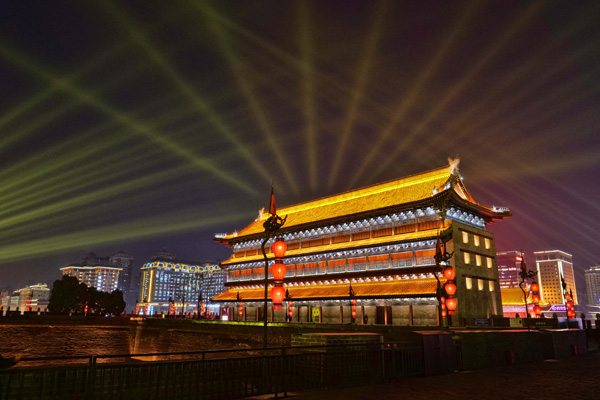
by successfulbob | cityscape photography, Guest Post, landscape photography, Lumix G85, travel photography
Travel in China – Xi’an
Guest Post – Ken MacAdams
Ken has been traveling in China and settling in for long periods. His last visit was for quite a while in Xi’an. Enjoy his images and commentary.
“I’ve been in Xi’an for nearly two months now. Living like a local has great rewards. In my apartment complex, I play on the jungle gym with the little kids (who come running and squealing to me – babbling away in Chinese that I can’t understand) when they spot me walking by! I go to the local street market to purchase my fruits and vegetables with my neighbors. I ride the bus with university students, businessmen and secretaries going about their daily lives. And nothing is more rewarding than the toothless old granny who bursts into a smile when I say “Neho” (hello) as we pass on the street!
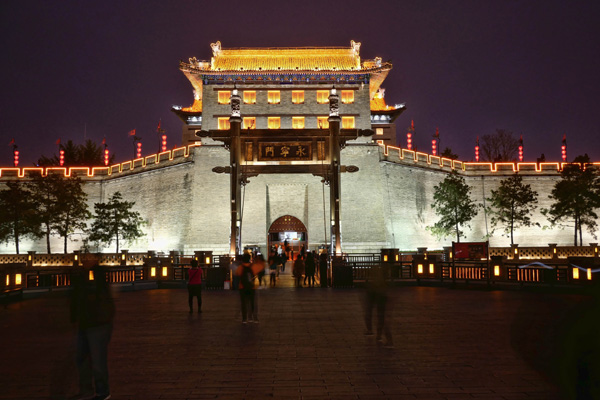 The drawbridge over the moat with the archers tower behind.
The drawbridge over the moat with the archers tower behind.
This wall is the only ancient city wall completely intact in China. This is one of the archers towers over the drawbridge. Besides longbows, they had crossbows capable of reaching 1/4 of a mile. It would have been deadly to try to gain entrance uninvited!
This is one of the archers towers over the drawbridge. Besides longbows, they had crossbows capable of reaching 1/4 of a mile. It would have been deadly to try to gain entrance uninvited!
The lights at nighttime are magic!
As a tall Westerner, I stand out, but I find the Chinese people very warm and welcoming, even if there is a huge language barrier! The “translator” app on my phone gets a daily workout, but many of the younger folks have studied some English, and although bashful about using it, they’ll often come to my rescue!
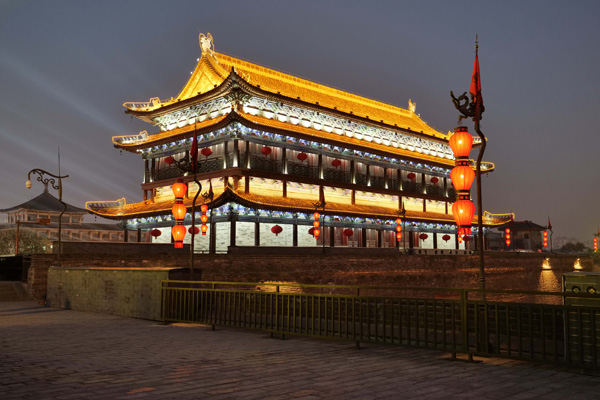 This is a temple on the ancient wall.
This is a temple on the ancient wall.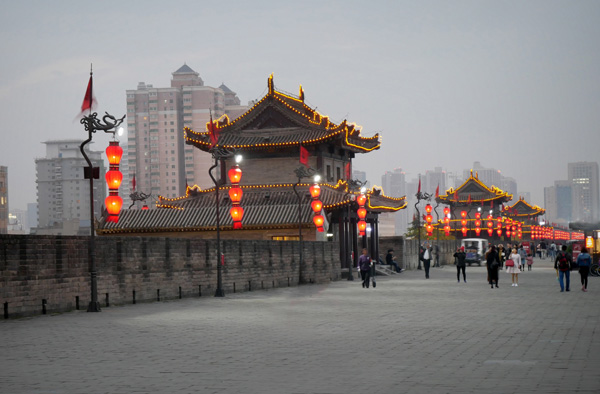 Guard towers stationed along the top of the wall. Note the smog in the atmosphere.
Guard towers stationed along the top of the wall. Note the smog in the atmosphere.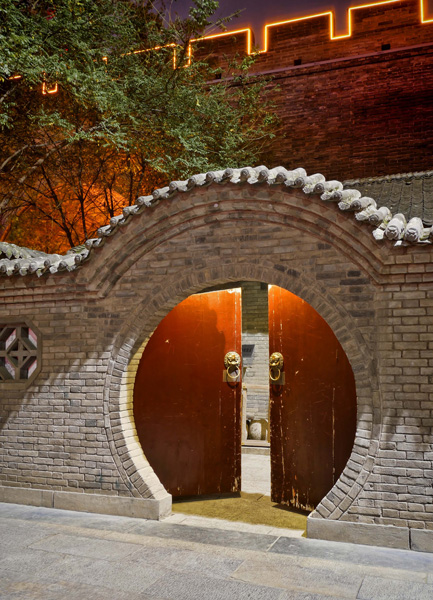 Entrance way along the wall.
Entrance way along the wall. Although I concentrate most of my time in Xian, I travel out to photograph in provinces to the east and west. China continues to expand routes serviced by their high speed “bullet” train, the futuristic aerodynamic trains that travels at 200 MPH. Travel between major cities is quick, quiet, and competitive with air travel. To me, traveling on the train, is just part of “living like a local.”
More from Ken and Xi’an, China Next Friday!
Ken has always loved to travel, so when he made a common connection with the fact that either a long day pounding the streets of some foreign city, or shooting the last dance at a wedding, a good part of his physical

weariness came from lugging around his big heavy DSLR. That’s when he started looking at alternatives – and ended up selecting Panasonic Lumix Micro Four Thirds gear.
Ken is rarely without a camera, and the next great photo travel experience – whether local or abroad – is always in the back of his mind! A longtime resident of the Four Corners, and when he’s not out on the road, he enjoys some of the great outdoor opportunities found there – mountain biking, hiking, and Jeeping.

by successfulbob | Guest Post, Marketing Monday, photography, success education
Portrait Pricing Guidelines with Steve Bedell – Part Three
Steve Bedell shares his thoughts on Portrait Pricing.
“As I reviewed my part 1 and part 2 of this pricing topic here on Successful-Photographer I was astounded that having so much knowledge I wasn’t worth about 27 million dollars! In any case, there was great response to the article about pricing in general and how to determine where you should be in it so now we continue with specifics.
Please note that much of this is my opinion but a great deal of it is what I’ve learned by PSTM (people smarter than me) so I stray from these guidelines at your own risk. With that in mind, let’s get going. Again, my mind kinda wanders all over the place so things may not be in proper order, but put up with me, the info is the same.
 ONE: Should I have a printed price list?
OK, I’m not kidding here. I see in online groups people asking for all kinds of feedback on their price list. NOT the pricing, but how the price list looks. They’ll discuss fonts, layout, etc. They’ll look nice and pretty but does it really matter? We’ll come back to that but question two is related so let’s get to that right now.
ONE: Should I have a printed price list?
OK, I’m not kidding here. I see in online groups people asking for all kinds of feedback on their price list. NOT the pricing, but how the price list looks. They’ll discuss fonts, layout, etc. They’ll look nice and pretty but does it really matter? We’ll come back to that but question two is related so let’s get to that right now.
TWO: Should I post prices online?
This one is MUCH easier to answer: NO!
Why? Because if someone goes online looking for a photographer and does a Google search and they see your 8×10 (the standard that they all know) is $195 and Joe’sSuckyPhotos.com is $29, which one will they choose? They’ll most likely choose Joe because they are just looking at prices and when you compare pricing in a vacuum you are looking at a commodity. If they visit your site and instead see your special booklet that tells them ‘5 Tips for a Great Family Portrait’ and lots of testimonials you have already set yourself apart from the bottom feeders.
OK, so now that we have a little background, should you have a printed price list?
I say yes, so it doesn’t look like you’re just pulling prices out of the air. But do you need to print up hundreds and send/email them to everyone who contacts you?
No.
You only really need one, and that’s for you to use in the sales room. Don’t believe me? Bradford Rowley uses a SLIDE of the price list during the sales session and only leaves it there for as short as possible. You want people focused on picking the best pose and the proper size portrait, you do NOT want them sitting there with their nose in a price list.
A little caveat here. I am talking about a PRICE LIST, not a Product Guide. A product guide will show sample of the products and a starting price or price range. One of the best I’ve seen is by Megan Dipiero. We featured Megan a little while ago, you can see her guide HYPERLINK “http://files.megandipiero.com/product-guide/?page=1” \t “_blank” here.
THREE: When should I show the price list?
There are different schools of thought on this.
Some say don’t ever show it, just let them come to the order appointment, write up what they want, then tell them the price.
Others tell them pricing during the consultation when the session is booked.
I’ve used both methods, they both work. I prefer the up front method, it makes me and them more comfortable at the sales session, less like I’m holding the images hostage. Do what you’re comfortable with and what works for you. Previous to a consultation, always use a price range instead of exact pricing, like ‘Our gift prints start at $95 and wall collections begin at $1800’ or something along those lines. They’ll have a better idea of why you charge what you do during the consultation.
FOUR: Good/Better/Best pricing
This model has been around since the dinosaurs. Why? Because it works! I have my ‘paper prints at level 1, canvas prints at 2, and Gallery Wraps and metals at level 3. Decide size first, then finish. This gives you an opportunity to make more income on the same sized print. As an example, my 16×20’s are $600/$750/$925. This may seem very low to some and high to others. Also, don’t just call them finish one, two, three. Use names like The Masters, The Venetian, etc and include a descriptive paragraph like ‘enhanced by our artist and bonded to natural fiber canvas’.
FIVE: Should I have a contract?
I read many posts where photographers sound like wannabe lawyers. I like to concentrate on the experience so introducing a contract into the mix just doesn’t work for me. You should have policies for payment but in 40 years of doing this I’ve had no need for a contract. Weddings, yes, portraits, no. It’s up to you.”
More to come as Steve brings the rest of this home in Part 4 on Successful-Photographer.
Steve Bedell has been a professional photographer for over 35 years. He has done weddings, portrait and commercial work but now restricts his business to portraits only.
Steve holds the Master of Photography and Photographic Craftsman degrees from the Professional Photographers of America and is a PPA Approved Print Juror.
commercial work but now restricts his business to portraits only.
Steve holds the Master of Photography and Photographic Craftsman degrees from the Professional Photographers of America and is a PPA Approved Print Juror.
He has been named the New Hampshire Photographer of the Year a record 8 times and in 2011 was awarded the New England Photographer of the Year title. His specialty is natural light portraiture.
He has written hundreds of articles for photo publications, taught classes and workshops nationwide and produced several lighting DVDs. His private newsletter, EPhoto, reaches over 2000 photographers. Steve was a regular contributor to Shutterbug magazine.

by successfulbob | Guest Post, Marketing Monday, photography
Portrait Pricing Guidelines – Part Two – Marketing Monday
with Steve Bedell
See Part One here
This article is from EPhoto Newsletter, a free bi-weekly newsletter for professional photographers. To subscribe for more great info contact Steve at [email protected].
Mistake number 4: NOT doing in person sales!
First, you have to remember I’ve been doing this since the mid 70’s. How else could we sell except for in person? I’m continually baffled by newbies who have been doing shoot-and-burn are afraid to do IPS.
To me, it makes no sense to do it any other way. If you want to make very little money from each session and not have your client get the beautiful products that they deserve with your professional guidance, post photos online. Then they can see all the photos, send links to every person they know, and not need to purchase a single thing. You just cut your knees off. Go do 10 more jobs for each one you could have done doing IPS.
IPS takes skill. There are many courses and ways available to you, go pick one; that is beyond the scope of this. It requires you to guide your client to choose the best images, discuss retouching, framing and artwork and also choose products that they will enjoy. This is critical if you want with income you deserve for your hard work and skill.

Mistake number 5: Retouching preview prints.
I see photographers online constantly bemoaning the fact that all they do is retouch and they live in front of the computer. Part of it is because they spend time ‘pre-touching’ prints because they don’t believe the client can visualize the final prints. Give them more credit and stop fixing 40 images when they may only buy 3-5. See how much time that saves you.
There may be some instances where the finished print is a composite or has things added for some reason but for routine portraits, you’re wasting a LOT of time.
Mistake number 6: Justifying your price
We’ve all seen the posts that go into great detail about how much it cost to be in business and produce prints. You have overhead, you have insurance, taxes, blah, blah, blah. And when photographers see these posts they all get on the bandwagon and love the post and use it to explain why their 8×10 cost $76.38.
Enough!
When you walk into a Mercedes showroom does the salesman there go through a laundry list of items like new factory they just built, how much health care is costing them, etc? Of course not! It’s a freakin’ Mercedes; you know it cost more because they have BRANDED their products.
Do you ask the jeweler why the Rolex cost more than the Timex? Of course not, they do not address the same market. So stop it!
OWN your pricing! Be proud of it instead of making lame attempts to justify it. Set yourself apart from the mass of bottom feeders who make a mockery of those who choose to excel in this wonderful business that is a mysterious combination of art and science.
I probably wandered off topic, got a little personal and didn’t tighten things up as much as I should have. Maybe I even turned this into a bit of a rant.
But that’s OK, I ain’t no stinkin’ journalism major, I’m a photographer who sees many struggling or moving down the wrong path and with all the help available out there, I’m a photographer who sees many struggling or moving down the wrong path and with all the help available out there, there is just no need for it!
I think it was Charles Lewis who once said ‘Only seek advice from those who are where you want to be.’ So stop asking your brother what he thinks of your pricing or asking your mother what she thinks of your packages. That also goes for asking the photographer who has been in the trenches for six months for their advice.
So just STOP IT. Learn from those who are where you want to be.
Next issue I’ll discuss how your price list should be laid out to get the sales you want. There are some pretty specific guidelines that help your bottom line tremendously.
Steve Bedell has been a professional photographer for over 35 years. He has done weddings, portrait and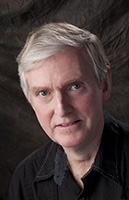 commercial work but now restricts his business to portraits only.
Steve holds the Master of Photography and Photographic Craftsman degrees from the Professional Photographers of America and is a PPA Approved Print Juror.
commercial work but now restricts his business to portraits only.
Steve holds the Master of Photography and Photographic Craftsman degrees from the Professional Photographers of America and is a PPA Approved Print Juror.
He has been named the New Hampshire Photographer of the Year a record 8 times and in 2011 was awarded the New England Photographer of the Year title. His specialty is natural light portraiture.
He has written hundreds of articles for photo publications, taught classes and workshops nationwide and produced several lighting DVDs. His private newsletter, EPhoto, reaches over 2000 photographers. Steve was a regular contributor to Shutterbug magazine.

 This is the Bell Tower with contrasting modern buildings in the background.
This is the Bell Tower with contrasting modern buildings in the background. This is an artist in the Art Gallery District who invited us in to join him for a tea ceremony. After visiting, he painted a calligraphy spread, and insisted we take it as a gift! Some of his work is hanging in the background.
This is an artist in the Art Gallery District who invited us in to join him for a tea ceremony. After visiting, he painted a calligraphy spread, and insisted we take it as a gift! Some of his work is hanging in the background. weariness came from lugging around his big heavy DSLR. That’s when he started looking at alternatives – and ended up selecting Panasonic Lumix Micro Four Thirds gear.
weariness came from lugging around his big heavy DSLR. That’s when he started looking at alternatives – and ended up selecting Panasonic Lumix Micro Four Thirds gear.




















